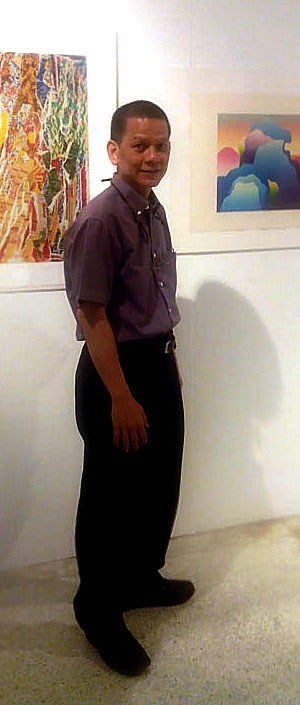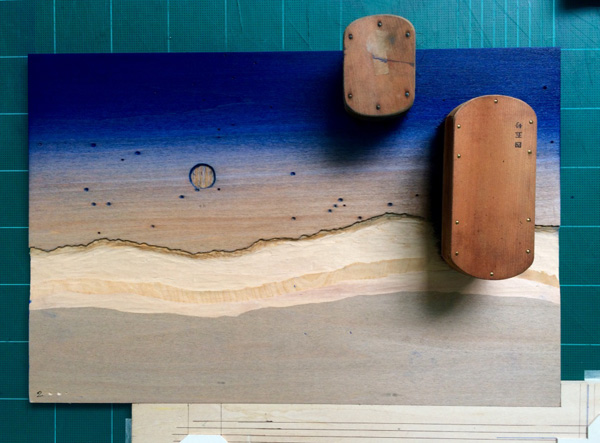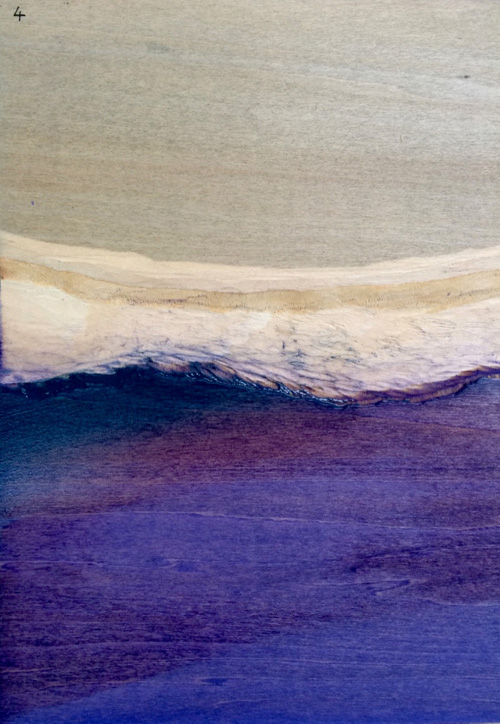|
In late August 2015, I had a chance to observe workshops of two female art lecturers from TAMA Art University Japan (in cooperation with
printmaking: FOFA CMU). They came to demonstrate the art of printmaking at the faculty of Fine Arts, Chiang Mai University Chiang Mai, Thailand. I also went to an exhibition
that was a collaboration between two universities. I went there as the observer for a few days.
Several times I've written about the printmaking of many artists in ChiangMai — most of them have their own studios to work and show
their artworks such as Kitikong Tilokwattanotai from C.A.P. (Chiang Mai Art on Paper) his studio is located at Nimmanhemin Road ChiangMai, and Associate Professor
Srijai Kuntawang at his Srijai Art studio in Maetang district Chiang Mai. Both of them are professional artists and lecturers from Rajamangala University of Technology.
Chaiyot Chandratita sent me a short article containing a famous quote from the German artist Gerhard Richter: “Art is not a product of
coincidence. The coincidence in itself cannot be the art." I remembered that I was a bit confused about the differences between painting and printmaking.
I have a photo of a Japanese warship, Kanrin Maru, on its perilous Pacific crossing, bound for San Francisco in early 1860.
(artist, Suzufuji Yujiro). I found that the picture looks like printed art. I like the movement of the warship. The process of
this photo was from painting or printing into lithography. Chaiyot Chandratita found this article by Romulus Hillsborough.
"Use the word paintings”, he wrote. Chandratita agreed with him. I said to myself, I would like to know more. And I wanted more
information from the artist's family. Unfortunately I cannot read Japanese.
While observing art lessons and printmaking activities, it appeared that the university provides full support for
printmaking as much as other kinds of art. Compared to normal painting, I find that the steps of printmaking are rather complicated and use a lot of tools.
This time I came to visit the Printmaking studio of Chiang Mai University and see the collaboration with universities from
foreign countries. I really hope that readers will understand and appreciate the art of printmaking which can be learned endlessly.
Here is a short interview with Chaiyot Chandratita:
JY: Please tell us briefly about the division of Printmaking, at the faculty of Fine Arts, Chiang Mai University.
CC: At the present Chiang Mai University has 20 faculties. The faculty of Fine Arts is the 12th faculty. It was established in 1983
with only Fine Arts and Thai Art divisions. In 1985 the faculty opened the division of Printmaking. In 2012 there was a major
change in the curriculum by reducing the total academic years from 5 to 4 years. Main principles of Printmaking’s creation were
completely retained but obsolete classes and procedures were removed out of the syllabus. The main focus now is the balancing
the development of techniques, thinking paradigms and learning skills of the 21st century under a contemporary context.
JY: What do you think about lecturers and graduate students of the Faculty of Fine Arts?
CC: In my view, they could create plenty of marvelous works in international standards by setting up art exhibitions. Many
received honorable awards from Thailand and foreign countries. I would like to introduce Associate Professor Thongchai
Yukantapornpong, a lecturer in the Printmaking division He received a scholarship for a research project in Art and Creative
Works from the National Research Council of Thailand. As a printmaking artist, I was honored to take part in the activity and
created “Doi Suthep Chiang Mai 2015."
It is a woodblock print using watercolor technique in Japanese style and its size is 30x45 cm. I used 11 woodblocks and 19 colors.
That research project was a good example of academic advances. It also pushed cooperation for teamwork among many people
including the director, lecturers, students, artists and printmaking artists. Apart from valuable submitted artworks
from the artists group in the project, academic networks in national and international were set up soon after. There was an
exhibition of printmaking between groups of students and lecturers from both the faculty of Fine Arts, Chiang Mai University and TAMA Art University Japan. This is also a
celebration of the 30th anniversary of of the founding of the faculty of Fine Arts in 2015.
JY: I would like to know about your role as a lecturer.
 CC: I was born in April 1959. I received Bachelor’s and Master’s degrees in Printmaking from
Silpakorn University in Bangkok. In 1988 I travelled to Chiang Mai and worked as a guest lecturer for a few years. From 1991 to the present, I have been
teaching in the division of Printmaking. During my career, I was assigned to administrative positions such as head of the division, head of the department
, assistant dean, vice dean and the director of Chiang Mai University Art Museum. It is challenging for me to be a part of the founding of a new division
which is called the division of Multidisciplinary Art. This division is headed by Professor Araya Ratchamroensuk. She is the first and current president
of the curriculum management department. She is also a printmaking artist who has more experiences and fame in Thailand and abroad. But for me, even
though I make some notable pieces of artwork throughout these years, I tend to focus mainly on my work as a lecturer. I am so
lucky to work with these colleagues and students as they always come up with new and interesting ideas. In my opinion, the
works and success of my students are the real proof of my achievement as a lecturer in the faculty of Fine Arts, Chiang Mai University. CC: I was born in April 1959. I received Bachelor’s and Master’s degrees in Printmaking from
Silpakorn University in Bangkok. In 1988 I travelled to Chiang Mai and worked as a guest lecturer for a few years. From 1991 to the present, I have been
teaching in the division of Printmaking. During my career, I was assigned to administrative positions such as head of the division, head of the department
, assistant dean, vice dean and the director of Chiang Mai University Art Museum. It is challenging for me to be a part of the founding of a new division
which is called the division of Multidisciplinary Art. This division is headed by Professor Araya Ratchamroensuk. She is the first and current president
of the curriculum management department. She is also a printmaking artist who has more experiences and fame in Thailand and abroad. But for me, even
though I make some notable pieces of artwork throughout these years, I tend to focus mainly on my work as a lecturer. I am so
lucky to work with these colleagues and students as they always come up with new and interesting ideas. In my opinion, the
works and success of my students are the real proof of my achievement as a lecturer in the faculty of Fine Arts, Chiang Mai University.
 |
JY: Is there anything you want to tell our readers?
CC: My 30 years as a printmaking artist began with the beauty, the serenity of forests and mountains which gave me some
touching inspirations. I also adapted the principles of Buddhism to connect with the ways of artistic creation and living under
social contexts that contained both desirable and undesirable things. This could point towards decreasing, abandoning and
giving up as well as escaping or grabbing something. It is not important to be scolded or complimented any longer but rather
to gain the true understanding of giving, being and living in the present. Art is the sending of good intentions that will not
separate oneself from friends and societies. People should begin with themselves appropriately first, and then all of their
creations can use some materials and contents from nature. These could be good for the inspiration to study and interpret
good internal abstract concepts and also remove a blocking line of personal identities and language limitations. Someone once
said that writing cannot convey meaning in the same way as speaking. The speaking cannot express meaning and experiences as well as it can portray something in the mind.
 |
|